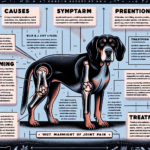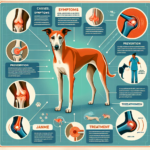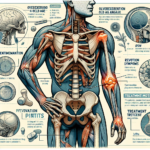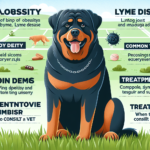Black and Tan Coonhound Joint Pain: Causes, Symptoms, Prevention, and Treatment

Introduction
The Black and Tan Coonhound is a distinctive and versatile breed known for its exceptional hunting abilities and loyal companionship. Originating in the United States, this breed was developed by crossing the Bloodhound and the Black and Tan Virginia Foxhound. The result is a dog with a keen sense of smell, remarkable endurance, and a friendly, outgoing personality. Black and Tan Coonhounds are often used for tracking and hunting raccoons, but they also make excellent family pets due to their gentle and affectionate nature.
Like many breeds, Black and Tan Coonhounds are prone to certain health issues. Among these, joint pain is a significant concern that can affect their quality of life. Joint pain in dogs can stem from various causes, including genetic predispositions, age-related wear and tear, and lifestyle factors. Understanding the causes, symptoms, prevention, and treatment of joint pain in Black and Tan Coonhounds is crucial for ensuring their long-term health and well-being.
Joint health is particularly important for Black and Tan Coonhounds due to their active lifestyle and working background. These dogs require strong, healthy joints to perform their duties effectively and to enjoy a high quality of life. Therefore, it is essential for owners to be aware of the risks and take proactive measures to maintain their dog’s joint health.
Breed-Specific Joint Pain Risks
Genetic Predisposition
Black and Tan Coonhounds, like many other breeds, have a genetic predisposition to certain joint-related issues. Hip dysplasia, a condition where the hip joint does not fit properly into the hip socket, is relatively common in this breed. This can lead to arthritis and significant pain over time. Elbow dysplasia, another genetic condition, affects the elbow joint and can also result in chronic pain and mobility issues. These genetic predispositions make it essential for breeders to screen for these conditions and for owners to be vigilant about their dog’s joint health.
Age-Related Risks
As Black and Tan Coonhounds age, they become more susceptible to joint pain and related conditions. Arthritis, a degenerative joint disease, is particularly common in older dogs. This condition causes the cartilage in the joints to break down, leading to pain, inflammation, and reduced mobility. Owners should be aware of age milestones, such as middle age (around 5-7 years) and senior years (8 years and older), when joint issues are more likely to develop.
Activity Level and Joint Stress
Black and Tan Coonhounds are known for their high energy levels and love of physical activity. Whether they are hunting, tracking, or simply playing, these dogs put a lot of stress on their joints. While regular exercise is essential for their overall health, excessive or inappropriate activity can exacerbate joint issues. Owners should balance their dog’s need for exercise with the importance of protecting their joints from undue stress.
Common Symptoms of Joint Pain in Black and Tan Coonhounds
General Symptoms
Joint pain in Black and Tan Coonhounds can manifest in various ways. Common symptoms include:
- Limping: A noticeable limp or favoring one leg over another can indicate joint pain.
- Stiffness: Difficulty moving, especially after rest, is a common sign of joint issues.
- Reluctance to Move: A dog that is hesitant to jump, climb stairs, or engage in physical activity may be experiencing joint pain.
- Swelling: Visible swelling around the joints can be a sign of inflammation.
- Behavioral Changes: Irritability, lethargy, or changes in appetite can also indicate discomfort.
Breed-Specific Symptoms
In Black and Tan Coonhounds, joint pain may also present with breed-specific symptoms. Due to their hunting background, these dogs may show a decreased interest in activities they once enjoyed, such as tracking or playing fetch. Additionally, their distinctive gait may become more pronounced or uneven when they are experiencing joint pain.
When to Consult a Vet
Owners should consult a veterinarian if they notice any of the above symptoms, especially if they persist for more than a few days. Early intervention can prevent further deterioration and improve the dog’s quality of life. Regular veterinary check-ups are also essential for monitoring joint health and catching any issues early.
Preventive Measures for Joint Health
Exercise Recommendations
Regular exercise is crucial for maintaining joint health in Black and Tan Coonhounds. However, it is important to choose the right types of activities. Low-impact exercises such as walking, swimming, and controlled play are ideal for this breed. These activities help maintain muscle strength and joint flexibility without putting excessive stress on the joints. Owners should avoid high-impact activities like jumping or running on hard surfaces, which can exacerbate joint issues.
Dietary Suggestions
A balanced diet is essential for supporting joint health in Black and Tan Coonhounds. Foods rich in omega-3 fatty acids, such as fish oil, can help reduce inflammation and support joint function. Glucosamine and chondroitin supplements are also beneficial for maintaining cartilage health. Owners should consult their veterinarian for specific dietary recommendations and consider incorporating joint-supporting supplements into their dog’s diet.
Weight Management
Maintaining a healthy weight is crucial for reducing joint stress in Black and Tan Coonhounds. Excess weight puts additional pressure on the joints, exacerbating pain and inflammation. Owners should monitor their dog’s weight and adjust their diet and exercise routine as needed to keep them at an optimal weight. Regular weigh-ins and body condition assessments can help ensure that the dog remains within a healthy weight range.
Early Screening and Monitoring
Early screening and monitoring are essential for catching joint issues before they become severe. Breeders should screen for genetic conditions like hip and elbow dysplasia, and owners should have their dogs evaluated regularly by a veterinarian. X-rays and other diagnostic tests can help identify joint problems early, allowing for timely intervention and management.
Treatment Options for Joint Pain
Non-Surgical Treatments
Non-surgical treatments are often the first line of defense against joint pain in Black and Tan Coonhounds. These may include:
- Medications: Anti-inflammatory drugs and pain relievers can help manage pain and reduce inflammation.
- Physical Therapy: Exercises and therapies designed to improve joint function and reduce pain can be highly effective.
- Lifestyle Adjustments: Modifying the dog’s activity level and environment can help alleviate joint stress.
Surgical Options
In severe cases, surgical intervention may be necessary to address joint pain. Common surgical options include:
- Hip Replacement: Replacing the damaged hip joint with an artificial one can significantly improve mobility and reduce pain.
- Arthroscopy: A minimally invasive procedure to clean out the joint and remove damaged tissue.
- Joint Fusion: Fusing the bones in a joint to eliminate pain from movement.
Owners should discuss the potential risks and benefits of surgical options with their veterinarian to determine the best course of action for their dog.
Alternative Therapies
Alternative therapies can also be beneficial for managing joint pain in Black and Tan Coonhounds. These may include:
- Acupuncture: This ancient practice can help reduce pain and improve joint function.
- Hydrotherapy: Water-based exercises that reduce joint stress while improving strength and flexibility.
- Massage: Regular massage can help alleviate muscle tension and improve circulation around the joints.
Lifestyle and Management Tips
Daily Care Routine
A consistent daily care routine can help manage and alleviate joint pain in Black and Tan Coonhounds. This routine might include:
- Morning and evening walks to maintain mobility without overexertion.
- Regular stretching exercises to keep joints flexible.
- Administering any prescribed medications or supplements.
- Providing a balanced diet with joint-supporting nutrients.
Modifying the Home Environment
Making the home environment more comfortable for a dog with joint pain can significantly improve their quality of life. Consider the following modifications:
- Installing ramps to help the dog navigate stairs or get onto furniture.
- Providing orthopedic beds to support their joints while resting.
- Ensuring that food and water bowls are at a comfortable height to reduce strain.
Long-Term Management
Long-term management strategies are essential for keeping a Black and Tan Coonhound active and happy despite joint pain. These strategies may include:
- Regular veterinary check-ups to monitor joint health and adjust treatment plans as needed.
- Maintaining a consistent exercise routine that balances activity with rest.
- Continuing to provide a diet rich in joint-supporting nutrients and supplements.
- Using alternative therapies like acupuncture or hydrotherapy as part of a comprehensive treatment plan.
FAQs About Black and Tan Coonhounds and Joint Pain
What are the early signs of joint pain in Black and Tan Coonhounds?
Early signs of joint pain include limping, stiffness, reluctance to move, and behavioral changes such as irritability or lethargy. Owners should monitor their dogs closely for these symptoms and consult a veterinarian if they persist.
Can joint pain in Black and Tan Coonhounds be prevented?
While genetic predispositions cannot be entirely prevented, owners can take steps to reduce the risk of joint pain. These include maintaining a healthy weight, providing a balanced diet with joint-supporting nutrients, and ensuring regular, low-impact exercise.
Are there specific exercises that are better for Black and Tan Coonhounds with joint pain?
Yes, low-impact exercises such as walking, swimming, and controlled play are ideal for Black and Tan Coonhounds with joint pain. These activities help maintain muscle strength and joint flexibility without putting excessive stress on the joints.
What dietary supplements are beneficial for joint health in Black and Tan Coonhounds?
Supplements such as glucosamine, chondroitin, and omega-3 fatty acids can support joint health. These nutrients help maintain cartilage health, reduce inflammation, and improve joint function. Owners should consult their veterinarian for specific recommendations.
When should I consider surgical options for my Black and Tan Coonhound’s joint pain?
Surgical options should be considered when non-surgical treatments are no longer effective, and the dog’s quality of life is significantly impacted by joint pain. A veterinarian can help determine the best course of action based on the severity of the condition and the dog’s overall health.
Conclusion
Joint pain is a significant concern for Black and Tan Coonhounds, but with proper care and attention, owners can help their dogs maintain healthy joints and a high quality of life. By understanding the causes, symptoms, prevention, and treatment options for joint pain, owners can take proactive measures to support their dog’s joint health. Regular veterinary check-ups, a balanced diet, appropriate exercise, and early intervention are key to managing joint pain effectively. By staying informed and vigilant, owners can ensure that their Black and Tan Coonhounds remain active, happy, and healthy for years to come.




